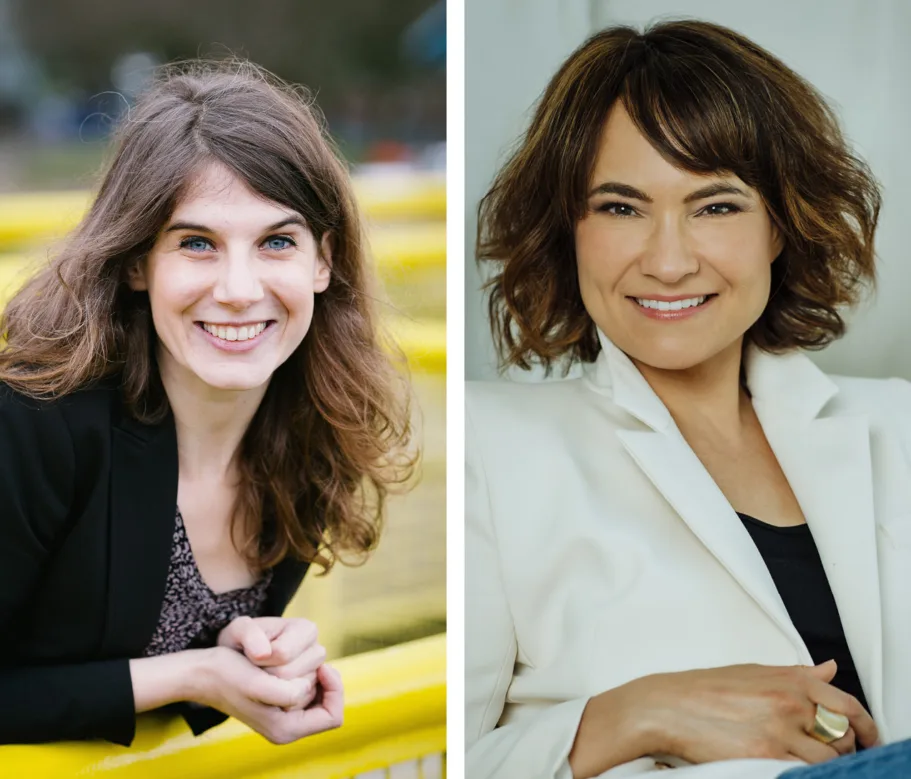La Befana: interview with Anaïs Pellin and Emilie Leclerc
As part of La Seizième’s artistic incubator for creative practice, author Anaïs Pellin has developed La Befana, a play for young audiences halfway between Italian folklore and initiatory tale. Directed by Emilie Leclerc, the show will be presented at Studio 16 on Saturday, April 6, before touring to elementary schools in British Columbia between April 8 and May 17, 2024, and then to Alberta with Edmonton’s Unithéâtre from May 21 to June 14, 2024. Anaïs and Emilie have shared their experience with us, with great complicity.
Anaïs, can you tell us more about La Befana‘s genesis? What drew you to this legend, Anaïs as an author and Émilie as a director?
Anaïs Pellin: Esther Duquette, the artistic and general director of La Seizième from 2016 to 2023, had asked me for a pitch. I had already written a text about my grandfather, my Nonno, who is of Italian origin. Back then, there was a lot of racism against Italian immigrants in Belgium. He really wanted to assimilate and rejected his roots, but at the end of his life, he started to speak Italian again – something I’d never heard him do – and to reminisce memories… and one day, he asked my grandmother if the Befana had come. That made a deep impression on me. I was interested in the topic of family heritage interested me, especially in immigrant families, who sometimes want to assimilate so much that they reject their heritage, and the generations that follow have to recreate that link. That’s what La Befana is about: how do you carry on the transmission from one generation to the next? Nonna passes on to her granddaughter her roots, the legends of her country, and she creates stories. The connection with British Columbia came with nature and the mountains. La Befana‘s pagan origins refer to the change of season from winter to spring, and to the link with nature. These are the themes I wanted to explore. It was essential for me that it was embodied by a woman, to address ecofeminism. It’s interesting to reappropriate legends: even today, the Befana has a much more worrying side than Santa Claus in Italy, who is seen as a jolly, good-natured fellow…. That’s also why I went for the witch theme.
Emilie Leclerc: What appealed to me was the legacy from one generation to the next, the fact that we have a little girl who dreams of being a witch, and the mystry of the fantasy world in which she evolves. I love that Sofia grows through her journey. The text also underlines the infinite cycle of life. The little girl dreams of being a witch and celebrates her connection with nature. The destruction of the fantasy world by men is very present in the story. Sofia sows hope, giving us the desire to believe that it’s possible to change things.
Through the prism of adventure storytelling and Italian folklore, the play tackles grief and the loss of a loved one. How did you go about dealing with these issues in a play for younger audiences, both in terms of text and staging?
E.L.: It was a very gentle process. You never see any shocking images, but you can feel that Nonna has gone, that she’s had some discomfort… Children are very intelligent: no matter how much you try to hide things from them, because you think they’re not ready, they know! They have great intuition. We follow Sofia as she comes to terms with this loss, and celebrates the fact that Nonna will always be present in her heart, through the stories she has received from her. It’s a beautiful way of approaching grief: it shows children that the people who leave will always be present through the stories they tell us or that we create together.
A.P.: Suzanne Lebeau, a Quebec author, says that you can address anything for a young audience as long as there’s hope. Hope is very present in both the text and staging. The fantastic aspect of the play allows us to tackle some rather dark subjects.
E.L.: There are some beautiful things in the text and the staging, like the character of Tom, the squirrel, who brings lightness to the picture. We also add sound and projections, which underline the fantasy.
Is it different to write and direct for young audiences?
E.L.: We know our audience: it’s French-speaking and Francophile, and above all, it’s vast: children from 5 to 12 come to see our shows, which is unusual! Not everyone has the same level of language and comprehension. For the staging, the important thing is to make the text as lively as possible: precise acting and action help to follow the story, and keep the children engaged and listening, even if they don’t understand every word. Anaïs’ text has a poetic language that is truly vivid, and says things clearly. We have no doubts about our audience’s ability to understand this text. We use few words, but the right ones.
A.P.: What interests me about the young audience is that there are also teachers and parents who attend the play. There are several levels of reading. Children can understand everything; maybe the younger ones won’t grasp the more philosophical aspects, but in any case, adults will. With characters like Tom, who are lighter, more physical or imaginary, we can reach the youngest and bring some magic to the table.
E.L.: With young audiences, we try to bring in more physicality. The advantage is that a gymnasium is such a vast space… Our staging choices are informed by our knowledge of the space and the technical tools available.
Emilie, your first experience as a director for Théâtre la Seizième was Le merveilleux voyage d’Inès de l’Ouest in 2022. How does that shape your work on La Befana today?
E.L.: The two experiences are very different. With Inès, it was very instinctive: it was as if I could see the text, as if I could hear it. With La Befana, the process is more delicate, it’s as if I were discovering things, there’s more of an exchange with the designers… And I’m less stressed! (Laughs) It’s fun because we have time to explore (there are four weeks of rehearsals, editor’s note).
What do you like about each other as a writer/director?
A.P.: We’ve worked on a number of projects together and know each other’s artistic worlds well. La Seizième paired us right from the start, from the very first labs, it was Emilie who read the text, we were already with Thérèse (Champagne)… Thérèse did all the development stages, and it’s so beautiful! During the first readings, we were very attentive to each other’s opinions. It just flowed.
E.L.: We recognize each other’s strengths. We’re very different, but we’re good listeners, we’re able to communicate. It was very circular in the labs, with respect for each other’s roles.
What would you say to Vancouver parents to get them to come to the theatre on April 6 with their little ones?
A.P.: La Befana is about family legacies and intergenerational transmission, so it’s important that they come! Francophone families in Vancouver very often come from elsewhere. How do we pass on our language, our roots, when we come from another place, or even another country? It’s an important question.
E.L.: There’s a lot of magic in La Befana!
La Befana
Anaïs Pellin
Family performance – Saturday, April 6, 2024
Studio 16 – 11am
Tickets on sale here

